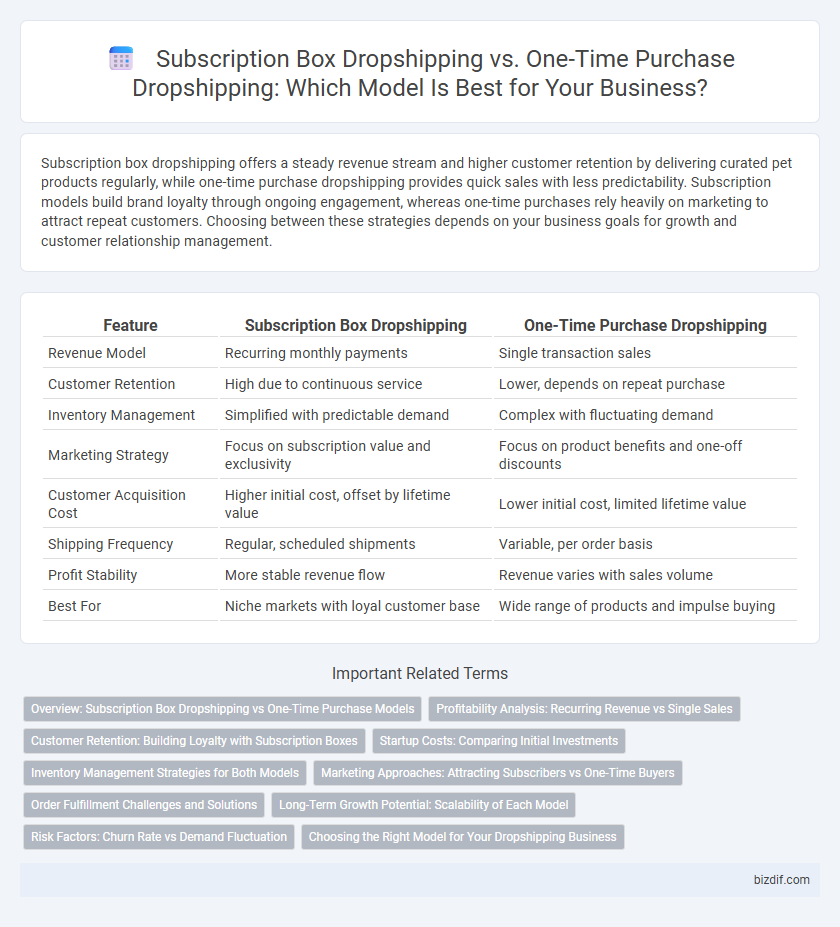Subscription box dropshipping offers a steady revenue stream and higher customer retention by delivering curated pet products regularly, while one-time purchase dropshipping provides quick sales with less predictability. Subscription models build brand loyalty through ongoing engagement, whereas one-time purchases rely heavily on marketing to attract repeat customers. Choosing between these strategies depends on your business goals for growth and customer relationship management.
Table of Comparison
| Feature | Subscription Box Dropshipping | One-Time Purchase Dropshipping |
|---|---|---|
| Revenue Model | Recurring monthly payments | Single transaction sales |
| Customer Retention | High due to continuous service | Lower, depends on repeat purchase |
| Inventory Management | Simplified with predictable demand | Complex with fluctuating demand |
| Marketing Strategy | Focus on subscription value and exclusivity | Focus on product benefits and one-off discounts |
| Customer Acquisition Cost | Higher initial cost, offset by lifetime value | Lower initial cost, limited lifetime value |
| Shipping Frequency | Regular, scheduled shipments | Variable, per order basis |
| Profit Stability | More stable revenue flow | Revenue varies with sales volume |
| Best For | Niche markets with loyal customer base | Wide range of products and impulse buying |
Overview: Subscription Box Dropshipping vs One-Time Purchase Models
Subscription box dropshipping offers recurring revenue through automated, scheduled deliveries that enhance customer retention and lifetime value. One-time purchase dropshipping relies on individual sales, requiring continuous marketing efforts to maintain cash flow without guaranteed repeat business. Selecting between these models depends on business goals, customer engagement strategies, and inventory management preferences.
Profitability Analysis: Recurring Revenue vs Single Sales
Subscription box dropshipping generates recurring revenue by securing continuous monthly payments, enhancing cash flow stability and increasing customer lifetime value compared to one-time purchase dropshipping. One-time purchase dropshipping relies on individual sales, which can result in fluctuating income and higher customer acquisition costs due to the need to constantly attract new buyers. Evaluating profitability reveals that subscription models often yield higher long-term profits through sustained engagement, while single sales depend heavily on volume and marketing efficiency.
Customer Retention: Building Loyalty with Subscription Boxes
Subscription box dropshipping enhances customer retention by delivering curated products regularly, fostering a consistent brand experience that encourages long-term loyalty. Unlike one-time purchase dropshipping, subscription boxes create predictable revenue streams and provide continuous value, which increases customer lifetime value. Personalized selections and surprise elements in subscription services strengthen emotional connections, reducing churn rates and boosting repeat business.
Startup Costs: Comparing Initial Investments
Subscription box dropshipping typically requires higher startup costs due to the need for inventory management, recurring billing software, and packaging materials that maintain product consistency over multiple shipments. One-time purchase dropshipping generally involves lower initial investments, primarily focused on setting up an e-commerce platform, product sourcing, and marketing without the complexities of recurring fulfillment. Evaluating these differences can help entrepreneurs allocate budget effectively based on their preferred sales model and customer engagement strategy.
Inventory Management Strategies for Both Models
Subscription box dropshipping requires inventory management to prioritize consistent stock levels for recurring product sets, ensuring timely deliveries and customer retention. One-time purchase dropshipping focuses on flexible inventory strategies to accommodate varying order volumes and diverse product selections, minimizing overstock risks. Utilizing demand forecasting tools and supplier coordination optimizes stock availability and reduces fulfillment delays in both models.
Marketing Approaches: Attracting Subscribers vs One-Time Buyers
Subscription box dropshipping leverages recurring revenue models by emphasizing customer loyalty and engagement through personalized, curated experiences that encourage long-term commitment. One-time purchase dropshipping prioritizes immediate conversions via targeted ads, seasonal promotions, and flash sales designed to attract quick, high-volume traffic. Marketing strategies for subscriptions rely heavily on storytelling, value propositions, and community-building to sustain subscriber retention, whereas one-time purchase campaigns focus on price incentives and urgency to drive fast sales.
Order Fulfillment Challenges and Solutions
Subscription box dropshipping faces order fulfillment challenges such as managing recurring shipments, inventory forecasting, and ensuring consistent product variety, which can lead to delays and customer dissatisfaction. One-time purchase dropshipping simplifies fulfillment by processing single orders without the need for ongoing inventory commitments, but it struggles with unpredictable demand spikes and supplier reliability. Solutions include integrating automated inventory management systems, partnering with reliable suppliers offering real-time stock updates, and employing predictive analytics to balance inventory levels and shipment schedules efficiently.
Long-Term Growth Potential: Scalability of Each Model
Subscription box dropshipping offers scalable recurring revenue streams through predictable monthly orders and customer retention, enhancing long-term growth potential. One-time purchase dropshipping generates immediate sales but faces challenges in sustaining consistent demand and requires continuous customer acquisition efforts. Businesses focused on scalability and steady cash flow often find subscription models more effective for long-term expansion.
Risk Factors: Churn Rate vs Demand Fluctuation
Subscription box dropshipping faces higher churn rates due to recurring customer cancellations impacting steady revenue streams. One-time purchase dropshipping encounters significant demand fluctuations, making inventory management and cash flow unpredictable. Businesses must evaluate these risk factors to optimize profit margins and operational stability.
Choosing the Right Model for Your Dropshipping Business
Subscription box dropshipping offers recurring revenue and increased customer retention by delivering curated products regularly, while one-time purchase dropshipping focuses on single sales with potentially higher profit margins per transaction. Selecting the right model depends on market demand, product type, and customer buying behavior, where subscription models excel in niches requiring ongoing engagement and one-time models suit trending or seasonal products. Analyzing customer lifetime value, operational complexity, and cash flow requirements ensures a dropshipping business aligns with sustainable growth goals.
Subscription Box Dropshipping vs One-Time Purchase Dropshipping Infographic

 bizdif.com
bizdif.com